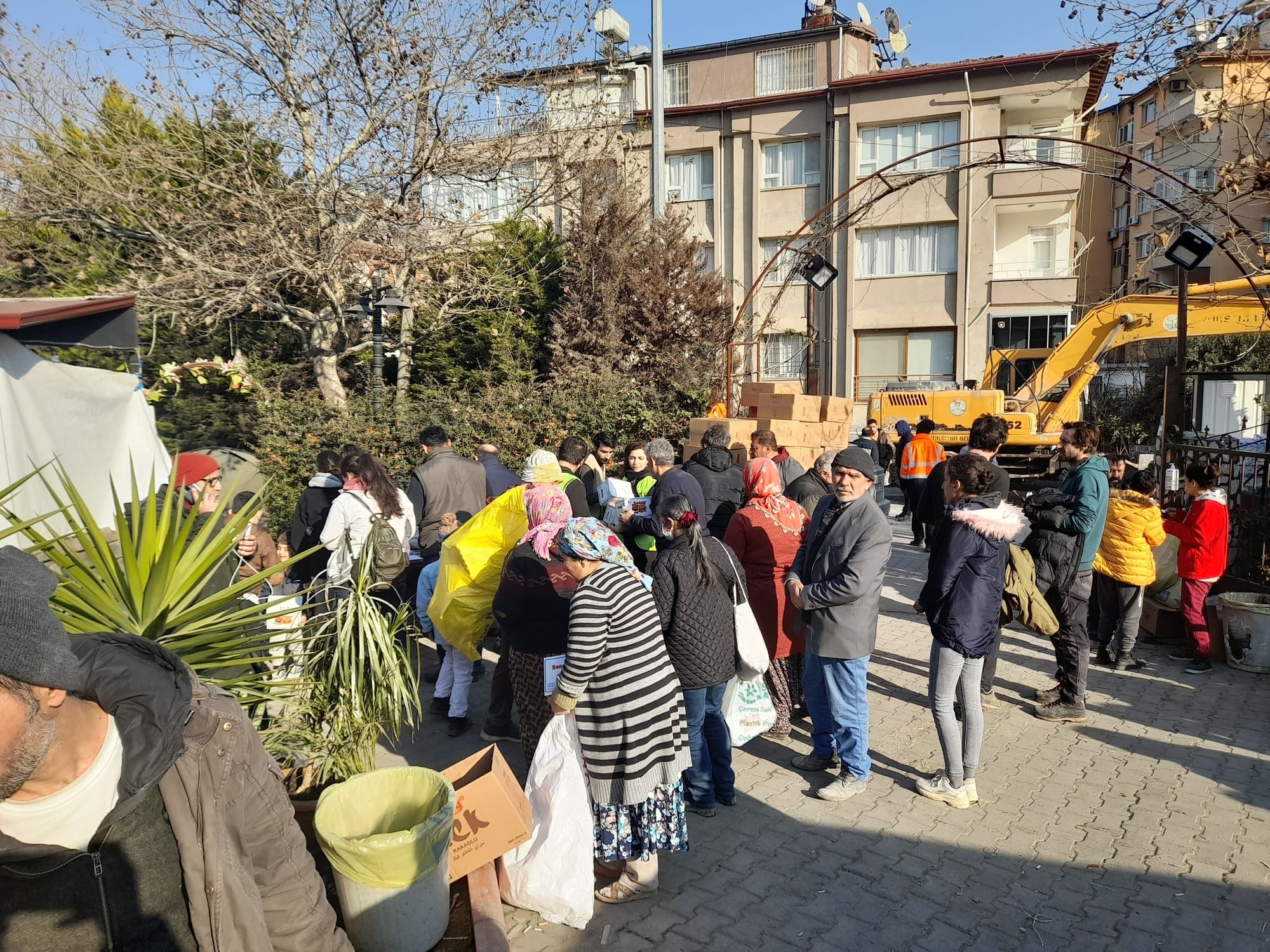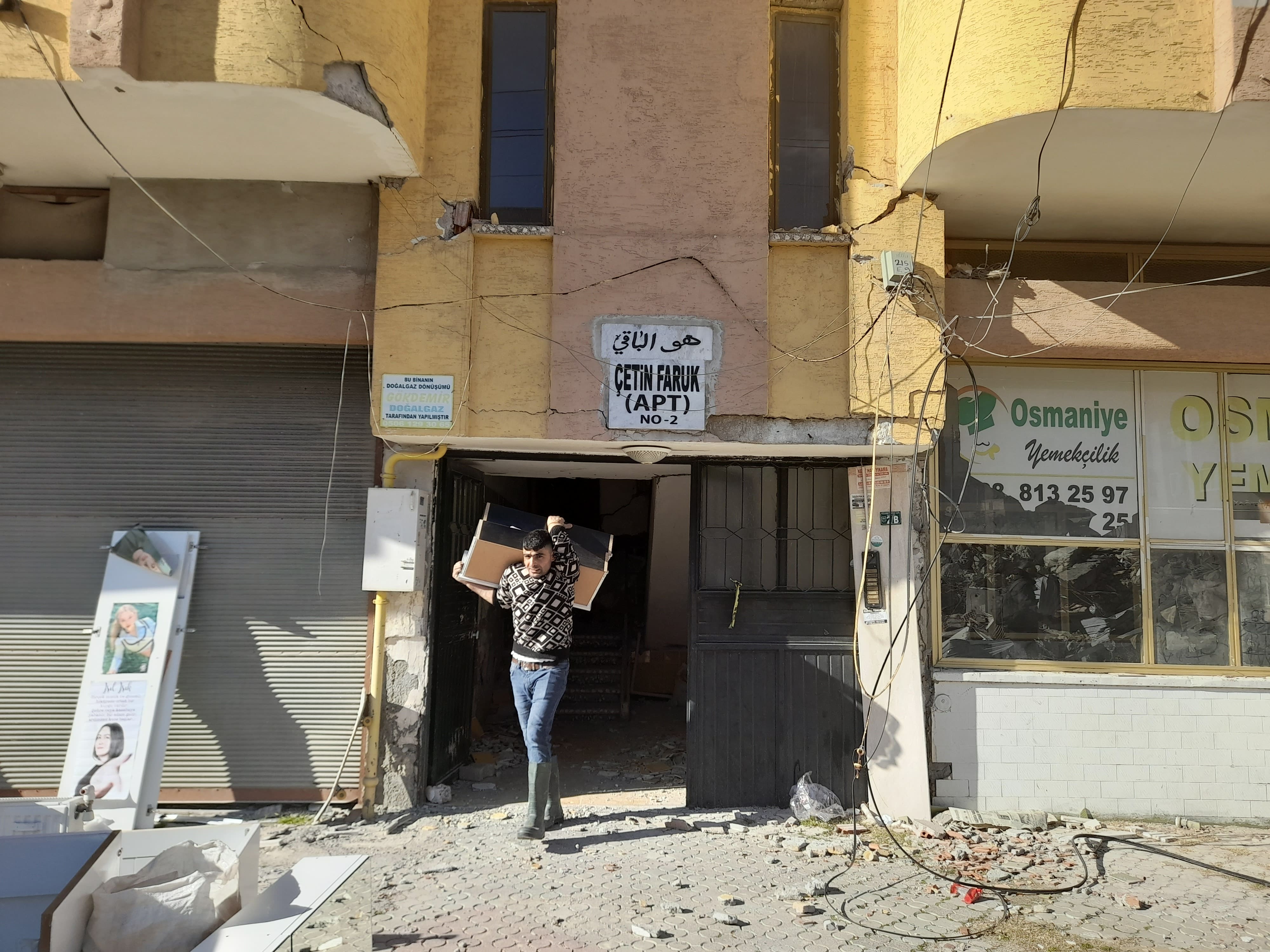News
Earthquake exposes Turkish government’s accumulated negligence
One month after the disaster, population still has to respond autonomously to assistance needs
There are multiple stories of Turkish rescue teams from the Disaster and Emergency Management Agency (AFAD) starting to explore buildings two days after the quake. Stories of families hiring excavators to dig their families out from under the rubble because no one was coming to help them; others trying to dig with their bare hands. Witnesses claim that, if rescue teams had arrived a few hours earlier, they would still hear the voice of someone trapped under the building. Others witnessed how neighbours wrapped dead bodies in blankets as they waited for the authorities to remove the bodies. Stories of whole families sleeping outdoors for days in sub-zero temperatures, of queues along the streets to get drinking water for the day. Stories of the insecurity of having to walk to the bathroom between half-collapsed buildings because there are no toilets, or not being able to collect your belongings or leave the city in case your house is ransacked.
One might think that the Justice and Development Party (AKP), which has been in government for 20 years, has given priority in dealing with the emergency to its municipalities, again forgetting the Kurds, the Alevis, and the Syrian refugees. This time, however, criticism of the Turkish authorities’ neglect is widespread throughout the quake-affected area. From Adıyaman, a Kurdish-majority but AKP-voting province, to Osmaniye, the traditional fiefdom of the government’s ally in the Turkish parliament, the ultra-nationalist MHP, and Gaziantep, where the earthquake devastated one of the few remaining refugee camps on Turkish soil.
Tamer Doğan experienced the İzmit earthquake in 1999, in which 17,000 people died, and also the Wan earthquake in 2011, in which 604 people died. That is why, when he heard about the earthquake in the early hours of 6 February, he set up an aid convoy together with the Marxist Social Freedom Party (TÖP), currently in coalition with the pro-Kurdish Peoples’ Democratic Party (HDP). The TÖP is a young party, formed in 2020, with a base of Christians and Alevi Arabs from Antakya. “In İzmit, the Red Crescent brought us old tents, some even broken. State aid was insufficient, but now we don't even have In Wan, there were dead people in the but the state was there. Nobody believed that ‘there was no state,’ nobody said so. Even though they only sent aid to their towns, there was a state presence. Now there are not even shops, there is no electricity,” he describes. Doğan is in central Antakya, in Hatay province, the area worst affected by the earthquake and where the authorities arrived at the latest. 20 days after the tragedy, more than 15,000 tents are still needed, according to local authorities.
Doğan claims that rescue teams started arriving in Antakya 48 hours after the earthquake. His testimony coincides with that of academic Hakan Güneş, a member of the Turkish Workers’ Party (TIP), also in coalition with the HDP. “Eight hours after the earthquake, we set up our camp here (in Antakya). We had no rescue teams, we are not professionals, but we managed to rescue about 200 people with our means,” he explains. The party has organised a space where they offer hot food, toilets, and sleeping space. Engineers and donations have helped them set up several container houses to make life more comfortable for victims who cannot or are unable to leave. “We now assist about 600 people in this park,” he says.
 A line to get some food in Antakya. / Photo: Lara Villalón
A line to get some food in Antakya. / Photo: Lara VillalónIn recent years, Recep Tayyip Erdoğan's government has concentrated almost all management of rescue and humanitarian relief efforts on AFAD, an institution created in 2009 by order of the current president, then prime minister. In an emergency, AFAD must respond earlier and has more responsibilities than the Red Crescent, the AKUT rescue group, or the army. Its current president, İsmail Palakoğlu, is an Erdoğan ally who has worked for years for the Ministry of Religious Affairs and lacks experience in emergency management. Some Turkish media last week published an internal AFAD report assessing the organisation's work after the earthquake in Düzce (2022), in the Black Sea region, in which more than 2,000 buildings collapsed. “We could not coordinate properly. The assembly area was poorly chosen, aid arrived late, and there was no unit to follow and coordinate the staff. [...] We had problems distributing food and the transport staff arrived two days late,” the report states.
“Erdoğan says he is an economist, he says he is a politician. He has changed the system (from parliamentary to presidential) and made all groups dependent on him. He has put people at the head of [government] bodies without asking whether they know or not. They make bodies like AFAD dysfunctional,” says Sera Kadıgil, a TIP member of parliament. After the severe earthquake in İzmit in 1999, the government activated a protocol for the military to intervene in emergencies when other security forces were not sufficient. However, after the 2016 coup attempt, the regulation was deactivated.
On the other hand, the Red Crescent has also been criticised for the slow deployment of humanitarian aid, especially tents. Last Sunday in February, the Turkish daily Cumhuriyet revealed that the Red Crescent had sold 2,050 tents to a private humanitarian organisation amid the earthquake crisis. Both parties confirmed the transaction. The news sparked protests in Istanbul by several left-wing parties, and police intervened in the rally, arresting more than 200 people.
Hours after the earthquake, the government made clear its intention to make AFAD the centrepiece of all humanitarian distribution. “We will not allow any coordination other than AFAD’s,” said Environment Minister Murat Kurum. In the last two weeks, under the cover of the state of emergency in the affected provinces, there have been multiple cases of the Turkish authorities requisitioning humanitarian aid from opposition organisations under the pretext of centralising assistance. For example, HDP MP in Adana Kemal Peköz reported that the police had seized the party’s aid truck for earthquake victims. TÖP¡s Doğan also said that the police had seized a dozen portable toilets needed in Antakya.
The field hospital deployed by Spain in İskenderun in Hatay also had a similar experience. A municipality of opposition social democratic CHP party had provided an ambulance to the Spanish hospital to help with the work of triage and sterilisation of equipment. After a few days, the AKP government of the province sent the Turkish ambulance away. This made the work of the Spanish doctors more difficult, according to a source at the field hospital.
In his first visit to the quake-affected area, Erdoğan admitted that there were some “shortcomings” in the deployment of rescue teams in the first hours after the quake. However, the president noted that the criticism came from “opportunists who seek to turn the pain to their political advantage.” He remarked that the earthquake was such a tragedy, but that “these things have always happened, they are fate’s plans.”
On the ground, dozens of journalists have reported arrests. Journalists claim that police officials have prevented them from accessing certain areas affected by the earthquake, and have even reported the seizure of their photographic material, including cameras and phones. At least four local journalists have been charged under the newly passed disinformation law, punishable by up to three years in prison, over publications critical of the government’s handling of the disaster. The Turkish authorities have also fined three television channels for the same reason. In addition, they have blocked access to a Turkish online forum, vital these days for requesting and managing humanitarian aid.
Buildings that kill
Turkey is located in a very active seismic zone, crossed by several faults in Istanbul, on the Aegean coast, in the east, and in the southeast of the country. After the terrible İzmit earthquake in 1999, buildings are obliged to follow regulations to ensure that they can withstand an earthquake. However, many buildings are approved without following the resolution, using sand-based cement or inadequate iron in columns. Subsequent work to remove parent columns to extend ground floors or add storeys to already approved structures is also common. The authorities have announced the arrest of at least 188 contractors who committed negligence in the construction of the buildings. For the victims, it is not enough.
Following the earthquake, at least 173,000 buildings have collapsed or have been severely damaged and must be demolished, the Turkish authorities have announced. The figure is expected to rise in the coming weeks as all buildings in the affected provinces are examined. As the days go by, questions and criticisms of the government’s building policies are growing, especially the amnesties granted by the Parliament to thousands of buildings that did not comply with the regulations. According to Pelin Pineda Giritlioğlu, head of the Chamber of Town Planners of the Union of Engineers of Turkey, 75,000 buildings in the earthquake-affected area received such amnesties. The government announced two days before the earthquake that it was preparing a new amnesty for thousands of construction companies..
 A man collects some belongings in Osmaniye. / Photo: Lara Villalón
A man collects some belongings in Osmaniye. / Photo: Lara VillalónFor this reason, lawyers are broadening the spectrum of those responsible for the collapse of thousands of buildings, and want to investigate the municipalities and publishing companies that approved the negligence. “We know that there is a lot of money in construction. Even though they know that some land is not suitable, projects are approved there. Eight-storey blocks are allowed where land does not support more than four floors. There is a lot of negligence,” explains lawyer Bedia Büyükgebiz.
Büyükgebiz, together with several bar associations, has launched an appeal for colleagues from all over the country to come to the quake zone to analyse the buildings and collect evidence. Before the rubble is removed, they photograph the collapsed buildings from every possible angle and take a small sample of concrete and iron from a column. Afterwards, they write a report that could later be used as legal evidence. “From the president to the last member of Parliament, from the Government or the opposition, all the local councils... There is no single culprit. It is all those who failed to take precautions, those who collaborated in negligence, starting with the president, the Council of Ministers, and the entire Parliament,” says Büyükgebiz.
It is also becoming increasingly apparent how negligence has impacted on individual buildings. At the public hospital in İskenderun, for example, one of the buildings collapsed completely. A 2012 assessment had warned that the 1960s building would not withstand an earthquake. It was 11 years ago. According to the law, it was the responsibility of the city council, at that time under the mandate of the opposition CHP party, to carry out the relevant structural reinforcement. It was not fixed. A year later, the AKP government passed a law allowing it to take over areas considered at risk of disaster. Although İskenderun fell under the plan, the building was not reinforced. In February last year, the boundaries of the city’s seismic region were redrawn, and the hospital was left out. One year later, it has collapsed, killing 70 people, including medical staff and patients.
